Last Updated on April 4, 2024
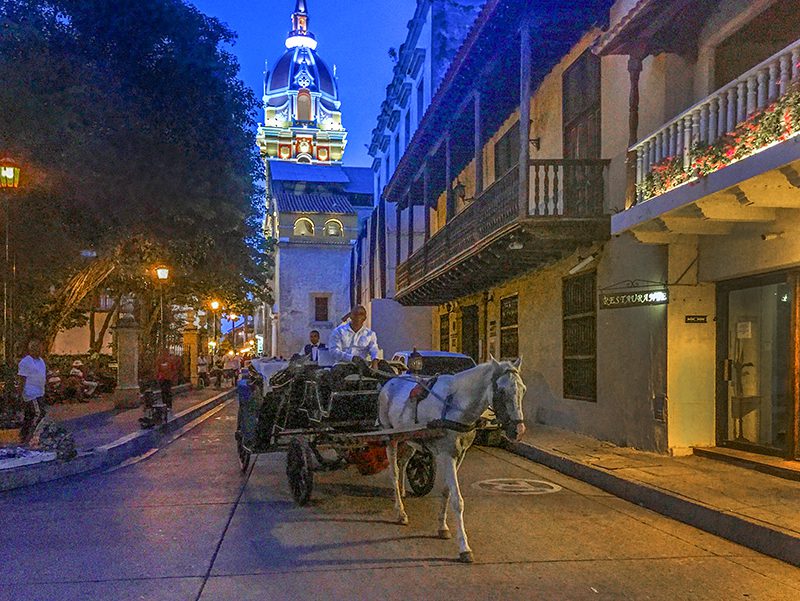
By Jim Ferri
Occasionally, one discovers a place that’s so different and beautiful it’s almost magical. And when it’s also affordable and close to home, we can’t help but wonder why we hadn’t visited before.
That’s precisely what happened to me when I found Colombia’s old Caribbean town of Cartagena, where there are many things for travelers to do. High on that list is just absorbing the beauty and ambiance of the place.
There’s no denying that Cartagena, especially its old town, is mesmerizing. One of South America’s oldest cities, it’s a former Spanish Colonial bastion built on slavery, sugar, and gold. Centuries later, however, it’s morphed into a hotspot in the Caribbean.
And, as you’re often told, it’s also the most popular Colombia getaway for the Colombians themselves. Spend a few days there, and it’s easy to see why.
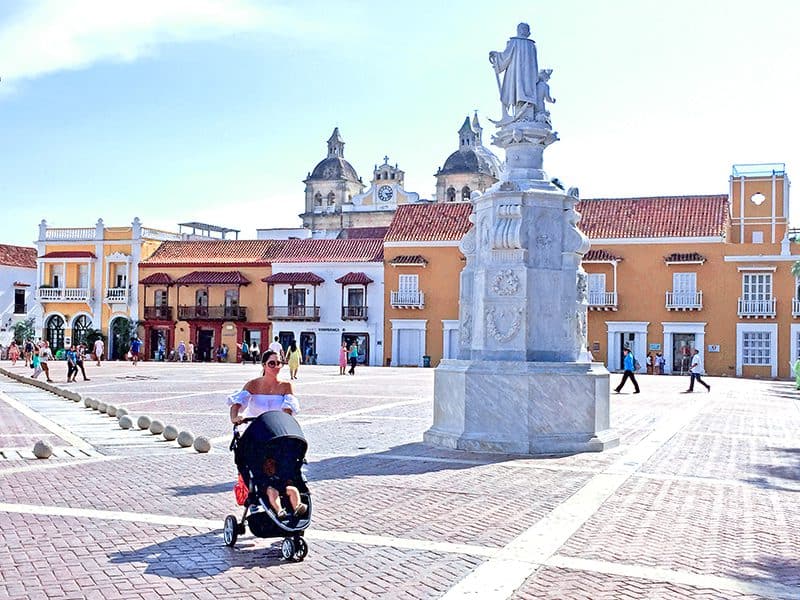
A Beautiful, Old City City
Officially known as Cartagena de Indias, it’s located on the northwest Caribbean coast of Colombia. Its old city, a UNESCO World Heritage Site, is mesmerizing.
Old buildings flaunt colorful hues, and flowers cascade from balconies jutting out above cobblestone lanes. It also has more than its rightful share of colorful colonial homes, many of which have been converted into B&Bs and boutique hotels.
A historic city, Cartagena is the Caribbean port through which the gold and other wealth plundered by the Conquistadores were shipped to Spain. On their return the ships often brought slaves from Africa.
Cartagena was the first Spanish colony in the Americas, and interestingly, was also the first city to declare independence from Spain. It was done with help from liberator Simon Bolivar, eight years before the rest of the country took the step.
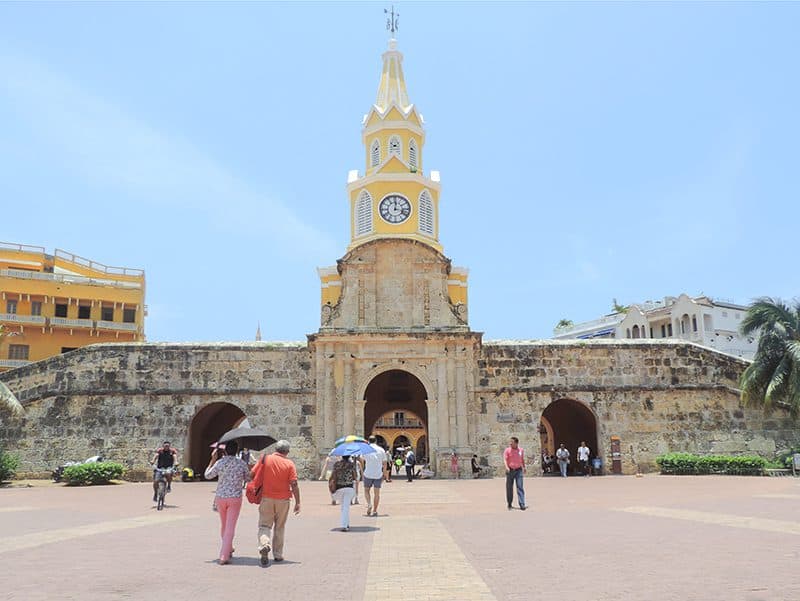
A Trip On a Whim to Cartagena, Colombia
I spent three days in Cartagena, which was the perfect amount of time to relax and explore this Colombian city, and get away from the world and its problems.
It’s a fantastic city rich in historical and cultural attractions, with plenty of good hotels, both chains and independents, and a smorgasbord of excellent restaurants. Protecting its character over the centuries are the 11 miles of wall that surround it. Within its walls you’ll find beautiful plazas and streets all over the city.
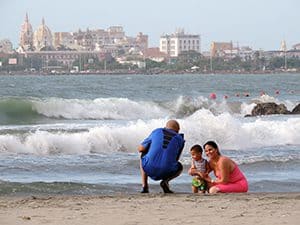
What’s more, perhaps even incredibly so, is that it’s safe and inexpensive. In fact, Cartagena, Colombia is also closer to Miami than some famous Caribbean islands.
Once a Caribbean backwater, it’s now morphed into one of the stars of the Caribbean. Travelers arrive daily on American, JetBlue, Spirit, and other airlines. Several cruise lines – including Norwegian, Carnival, Princess, and Disney – also include it as a port of call.
I decided to visit the city only a few days after seeing a sale fare to Cartagena from Ft. Lauderdale on JetBlue. Impulsively, I booked it and then researched hotels.
I also found plenty of hotel options, especially outside the old walled city in Bocagrande, that’s a little ribbon of a peninsula that runs along the seashore from the Old City down to the Hilton at its end.
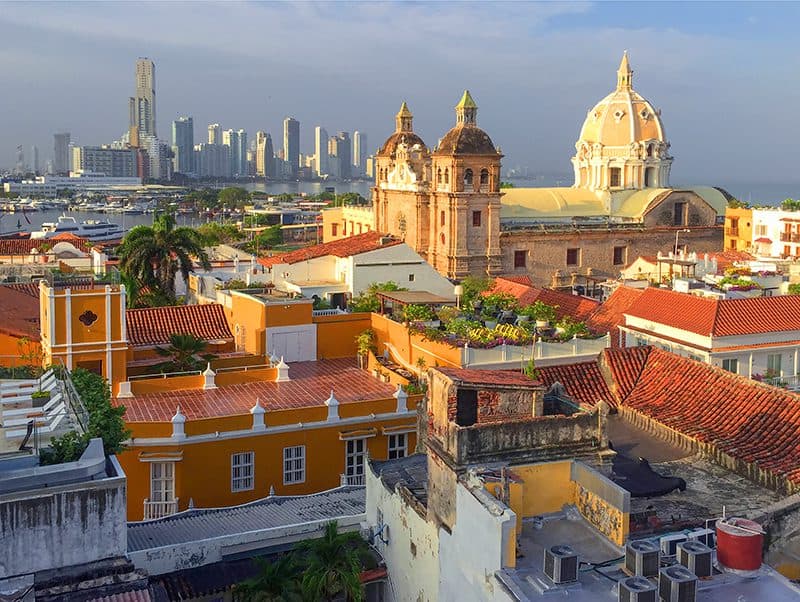
Choosing the Old Walled City
But Bocagrande wasn’t for me. Instead, I wanted to stay in the walled Old City since I was more interested in its history and culture and wanted to visit some of its old restaurants.
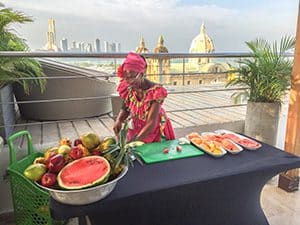
I also wanted to immerse and feel the “oldness” of this nearly 500-year-old city and not be surrounded by the glass and steel of modern hotels.
The Movich Hotel Cartagena, a 32-room luxury hotel, was a perfect choice, since it was comfortable and well-located. And the price wasn’t exorbitant, the breakfast on the rooftop was wonderful, as were the rooftop drinks at sunset.
In addition, it provided a spectacular view of the city from the bar and pool on its rooftop. It was a great venue for both breakfast and an evening drink.
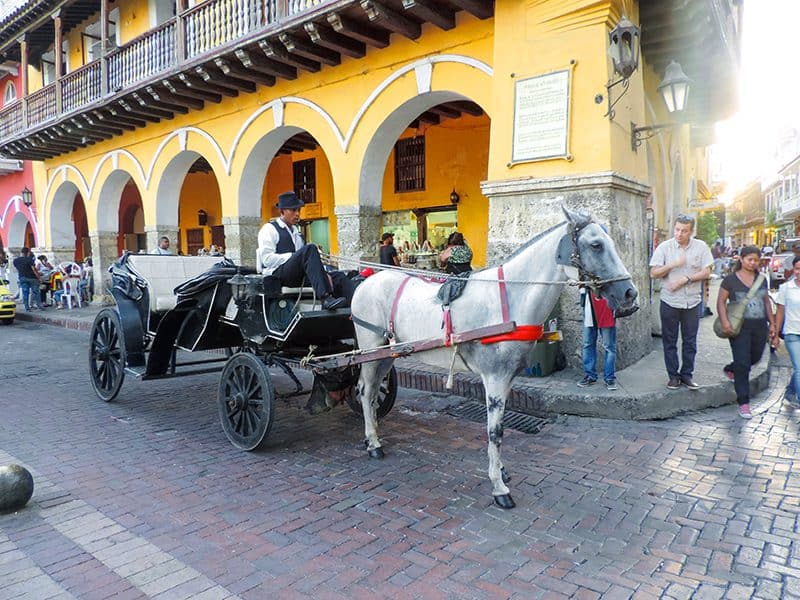
Toss the Guidebook
What one needs to do in Cartagena’s old town, is to throw away the guidebook. Cartagena is one of those places in Colombia where it’s best just to ramble aimlessly. This allows you to better appreciate the “wow” factor of its colorful crisscrossing streets.
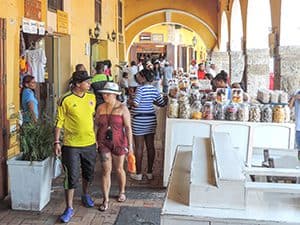
In Cartagena, more than elsewhere, however, tourist maps can be quite misleading. They make the historic part of the city, the main draw for travelers, look larger than it is.
Don’t be mislead. In reality, the walled city is so compact it doesn’t take much time to walk across it at all. But, on the other hand, I constantly was sidetracked by scores of exciting things I found along the way, such as the confectioners in the colonnade of the Plaza de los Coches.
Be aware that it gets hot in Cartagena, and the humidity can often be quite high. So it’s best to do your sightseeing in the morning before the sun rises high in the sky. Then you can take advantage of the sidewalk shade as you wander.
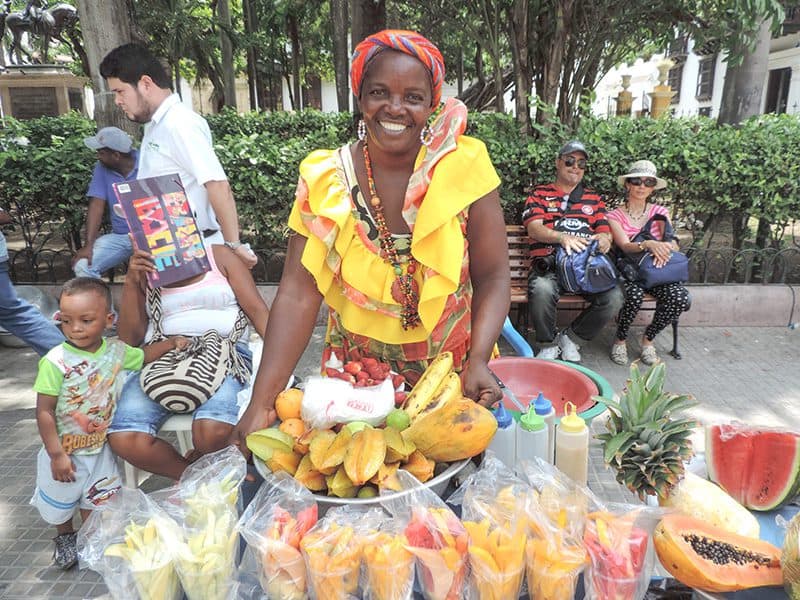
Visit the Plazas, One of the Best Things to Do in Cartagena, Colombia
At times your mornings will begin with the fresh tropical fruit, perhaps bought from the Palenques. (It may also begin with the best coffee you’ve ever tasted since this is Colombia, after all.)
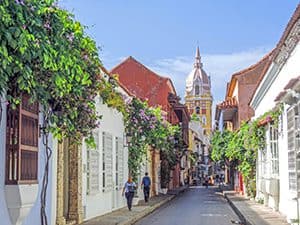
Around the old city you’ll see Palenques, women in Crayola-colored dress balancing bowls of fruit on their head. They’re both a part of the history of the city, as well as a symbol of it.
Originally, the Palenques came from the small town of San Basilio de Palenque in Colombia south of Cartagena. It was one of the first places in the Americas to be freed from slavery and their dresses are a symbol of the city. Note that if you want to take a photo of them, it’s customary to give them a tip.
In the mornings my favorite place to see the Palenques was in Plaza Santo Domingo (at the corner of Carrera 3 and Calle 35). It’s a charming square bordered by numerous restaurants. The plaza is most famous for the statue Figura Reclinada a large statue by Fernando Botero, Colombia’s greatest artist.
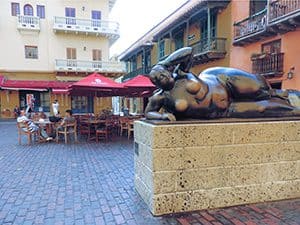
But I found that you feel the charm of Cartagena, Colombia more intensely later in the day. As evening drifts in, the gates in the old city walls close to traffic. Then the streets fill with people, and the air with music, as cobblestones resonate with the clip-clop of horses pulling carriages. Overall, it’s a wonderful respite from the traffic back home.
I found Plaza de Bolivar, a picturesque, shaded park around the corner from my hotel to be wonderful. The plaza was initially named the Plaza de Inquisición for the Palacio de la Inquisición that dominates one of its sides.
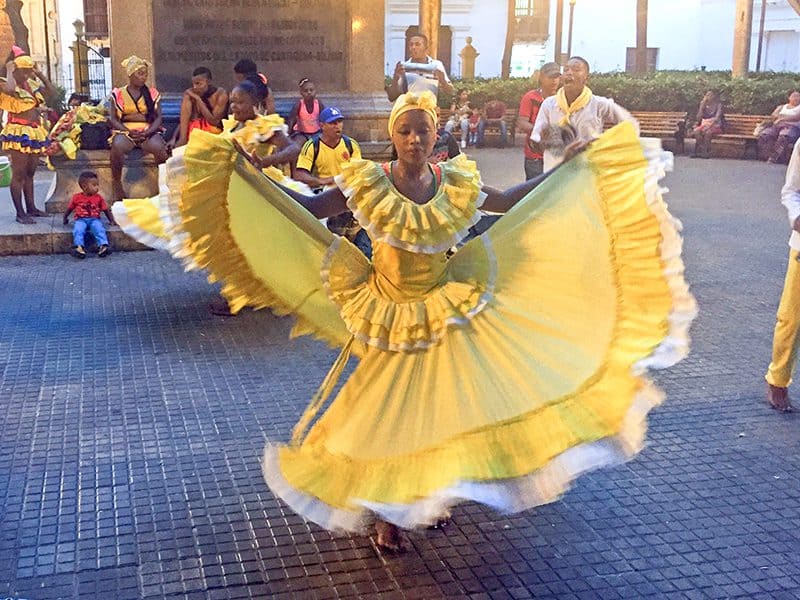
Palace of the Inquisition
Each night in Cartagena, Colombia, I found an impromptu folk dance in the Plaza de Bolivar. Loud and colorful, it attracted small crowds of people who tossed pesos into the passed hat after the performance.
Bolivar Plaza sees plenty of people during the day, as well. Everywhere you encounter vendors selling everything from paintings, jewelry, and sunglasses to watermelons and water.
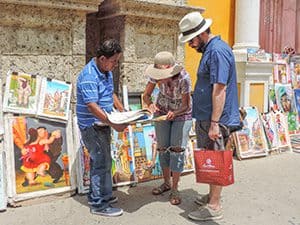
Visit the park area near the cathedral to view the sidewalk artwork.
Cartagena’s Palace de Inquisición, on the other hand is as interesting as it is horrific.
It’s interesting because you learn about the Inquisition around the world. Horrific when you learn about the implements used in torture.
Don’t leave without going upstairs, although the small exhibit of religious artifacts on the second floor is only mildly interesting. Still, on the third floor, there are small exhibits on the founding and history of Cartagena, as well as about the tribes that formerly lived in the region.
Unfortunately, most of the descriptors are only in Spanish.

Interesting Museums to Discover
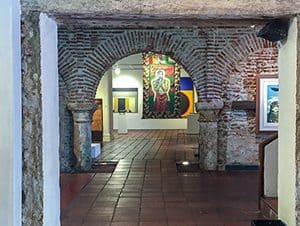
Cartagena doesn’t have any large museums, except the Colombia Naval Museum, which I avoided after learning it was more perfunctory than informative. There are, however, a few small and interesting museums and boutiques in the area. Many are also just the right size to escape the mid-day heat for an hour or so.
One is the Museo del Oro Zenú, a modest museum on Bolivar Park directly across from the Inquisition Museum. It has a beautiful collection of gold and pottery of the Zenú people who inhabited the region before the Spanish conquest.
Another is the small Museum of Modern Art, which is more of a gallery than a museum. Although I’m not a lover of modern art, I found it contained some interesting works that were not just indecipherable blobs of paint on canvas. It’s just the right size to spend an enjoyable half-hour or so.
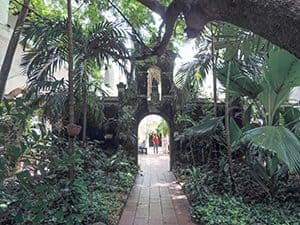
The museum is on the Plaza de San Pedro, named for the monk who spent his life ministering to the enslaved brought from Africa. Near the church of St. Pedro of Cleaver, there’s a large statue of the saint and a slave. You’ll find it’s one of the good photo ops in Cartagena, Colombia.
To enter the austere church, you must buy the 11,000-peso admission for the adjacent convent. Buy it since the convent is more interesting than the church, and it entitles you to an enjoyable stroll about the convent’s small shaded garden.
Outside on the plaza, you can’t miss, and shouldn’t, the small, whimsical metal sculptures of Cartagenians going about their daily lives.
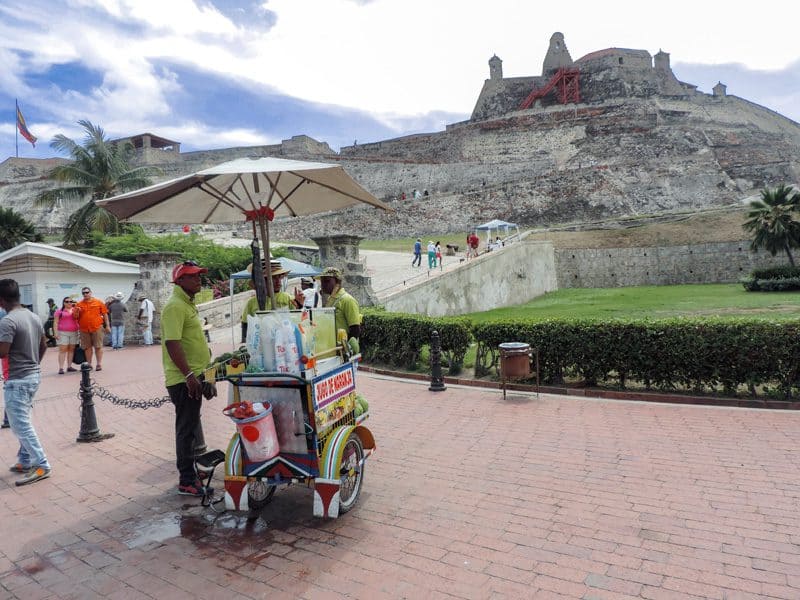
Visit Castillo San Felipe de Barajas
One day I took the Hop On – Hop Off tour bus to the Castillo San Felipe de Barajas, Cartagena’s massive Spanish fort, the largest in the Americas. In addition to Cartagena, it’s also one of the most famous landmarks in all of Colombia.
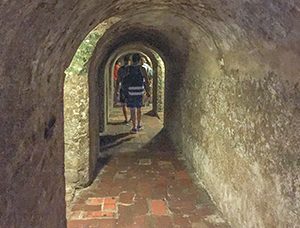
It was constructed in 1657 to protect the city from pirates intent on looting the treasures previously looted by the Spanish. It’s an engineering marvel that took 120 years to complete and despite being attacked on numerous occasions, it’s so large it was never conquered.
Although initially concerned about walking the roadway up to the top, I found it relatively easy. At the top I found a maze of tunnels beneath the fort. Each six feet tall and only a few feet wide, it allowed personnel and supplies to be moved rapidly. Today, however, it’s not only a great respite from the midday heat, but also provides great views of the city.
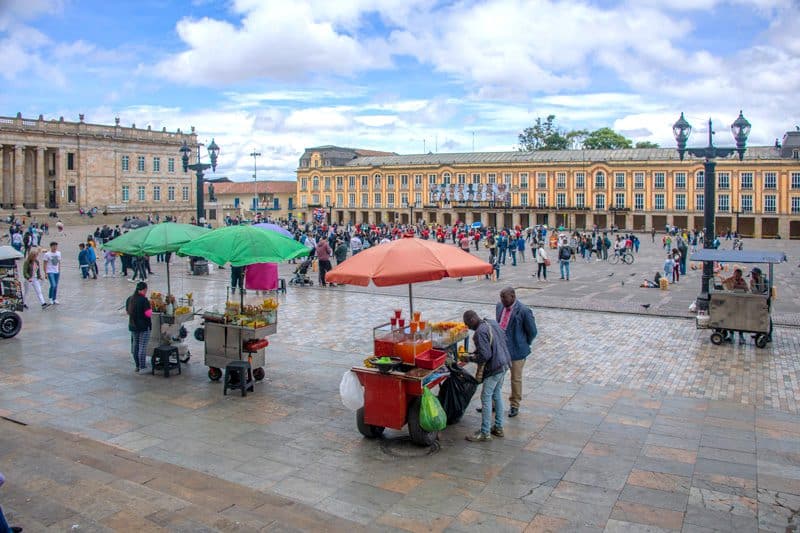
And While You’re In the Neighborhood…
There are plenty of other places to visit in Colombia after visiting Cartagena. One that immediately comes to mind is Bogota, the country’s capital.
Another well worth a visit is Santa Marta, considered by some to have the best beaches in Colombia. Many also consider its terrain, ranging from beautiful Caribbean beaches to forested mountain ranges to be an exceptionally distinguishing feature.
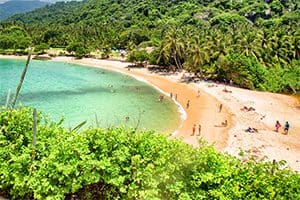
The city of Santa Marta and the surrounding area is home to four different ethnic groups, the reason UNESCO declared the area a Biosphere Reserve and World Heritage Site in 1979.
In addition, Santa Marta, is also popular for its bird-watching and wildlife. In fact, Columbia has a phenomenal 1900 different bird species, approximately 18% of the entire world species.
The nearby Santa Marta mountains are one of the most popular of all the country’s birdwatching locations.
Whether you’re going for the birds, the beaches or anything else, you’ll find one of the easiest ways to plan a trip to Santa Marta is through 12Go, a worldwide transportation service that books train, bus, ferry, transfer and flight tickets worldwide. If you’re going from Cartagena to Santa Marta look at these good options the company offers.

Leave a Reply